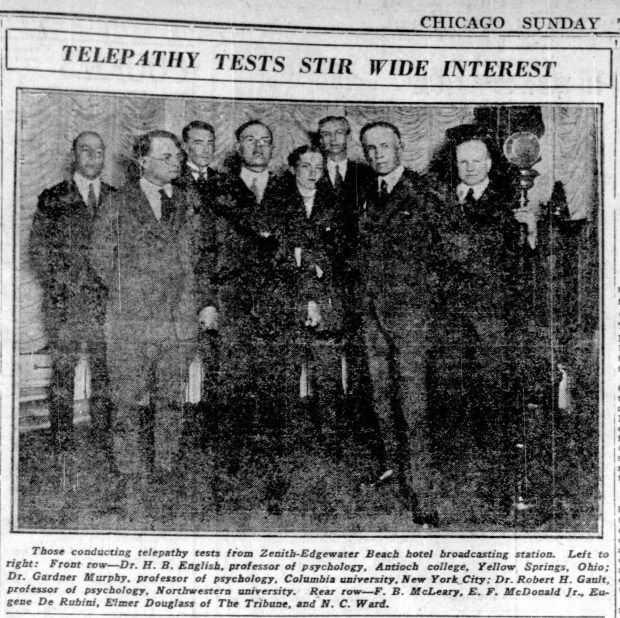We’re checking in on our friend Paul Durica, director of exhibitions for the Chicago History Museum, as he continues to wade daily through pages of the Chicago Tribune from 100 years ago. We’re sharing a few of his finds from last month here, but many more can be found on his website, pocketguidetohell.com.
But that’s not all that’s on Durica’s plate. This weekend he’s going a little bit country. (Did you know Chicago played a major role in the country music genre?) To mark the 100th anniversary of the debut of “National Barn Dance” on WLS, he is hosting “Hey, Hey, the Gang’s All Here: A Chicago Barn Dance” Saturday at the Hideout, 1354 W. Wabansia Ave. Shows start at 5:30 p.m. (all ages) and 8:30 p.m. (21 and over). Tickets cost $20 in advance, or $25 the day of the show. More details are available at hideoutchicago.com.
Column: There once was a time when our city was the country music capital
March 2, 1924: Can thoughts be transmitted over radio?
Three university professors gathered at Chicago’s Edgewater Beach Hotel to appear on radio station WJAZ’s 10 p.m. broadcast. They wanted to test out a novel idea — could their thoughts be transmitted over airwaves to listeners at home? The trio prepared a 12-part test as part of their investigation.
“For a number of years, psychologists have been conducting experiments with telepathy,” station superintendent E.F. McDonald Jr., told listeners. “But tonight by means of radio three psychologists will make a test with thousands of persons at one time.”
A preliminary study of the data found that despite more than 2,000 participants, no one answered all 12 items correctly. This led Columbia University’s Gardner Murphy, who analyzed the results, to conclude that further experimentation would be necessary.
March 7, 1924: ‘You might as well bury my carcass’
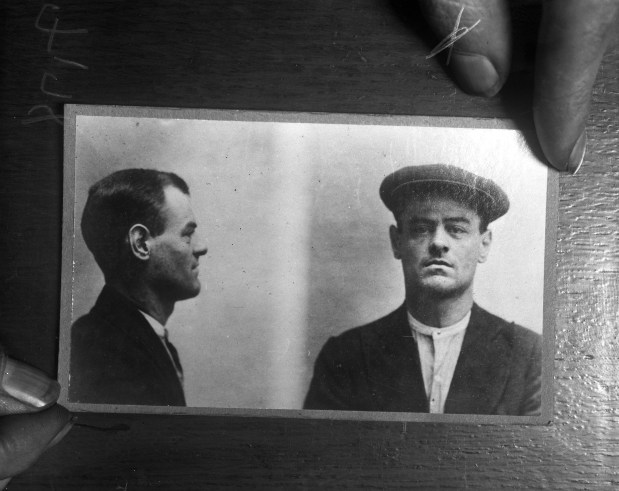
Police had been searching Chicago’s underworld for answers ever since the bodies of suspected low-level bootlegger John Duffy and his new bride Leah Exley — called Maybelle by the cabaret crowd, according to the Tribune — were discovered dead, he in a snowbank on the southwestern edge of the city and she in their apartment in late February 1924. Both had been shot to death.
Evidence of the murders and other crimes initially pointed to “a small group of Chicago millionaire bootleggers, robbers and gangsters,” the Tribune reported. The suspected ringleaders — “Barney Bertsche, Dean O’Banion and Dan McCarthy.”
After wading through the mess of mobster finger-pointing, police came to the conclusion that Duffy killed his bride in their apartment and then he was disposed of — possibly after making a mess that required the big boss to step in.
William Engelke, a witness and underworld hanger-on, stated in court that O’Banion led Duffy into a waiting car just before murdering him. Engelke knew this revelation could mean the end of his own life was near.
“Now that I have named O’Banion publicly you might as well bury my carcass at Roosevelt Road and Newberry Avenue,” he told the court.
March 15, 1924: Gandhi ‘weary’ but ‘honest, even as his enemies admit’
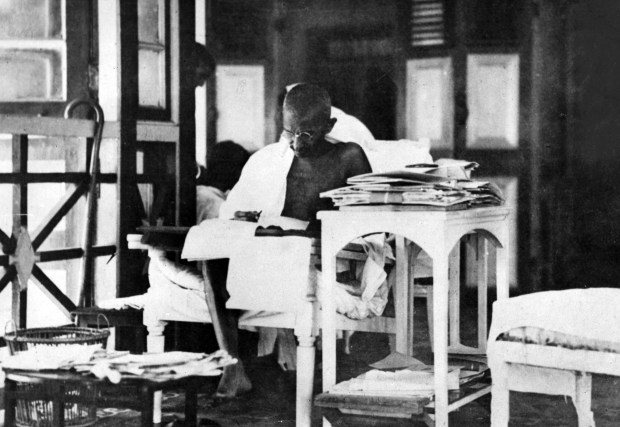
Just weeks after being released from prison to seek medical treatment, Indian civil rights leader Mahatma Gandhi sat down with Tribune correspondent Thomas Ryan to discuss his next steps — setting up spinning wheels, establishing nongovernment schools for the country’s caste of untouchables and temperance.
Gandhi said that India suffered a great disadvantage, as the natives had been “emasculated” as soldiers since the British came to the country.
“What I want is the end of the Indian’s mortal fear of the white skin, which was more prevalent when I was a boy than now,” Gandhi said. “Your state is not so clean (he told the reporter); what about your Negroes?”
Then Gandhi spoke about the exclusion of Booker T. Washington from a political gathering in Washington, D.C. “But he said that America’s record in the Philippines was splendid, so far as he knew,” the Tribune reported.
March 15, 1924: Aldermen break out in fisticuffs
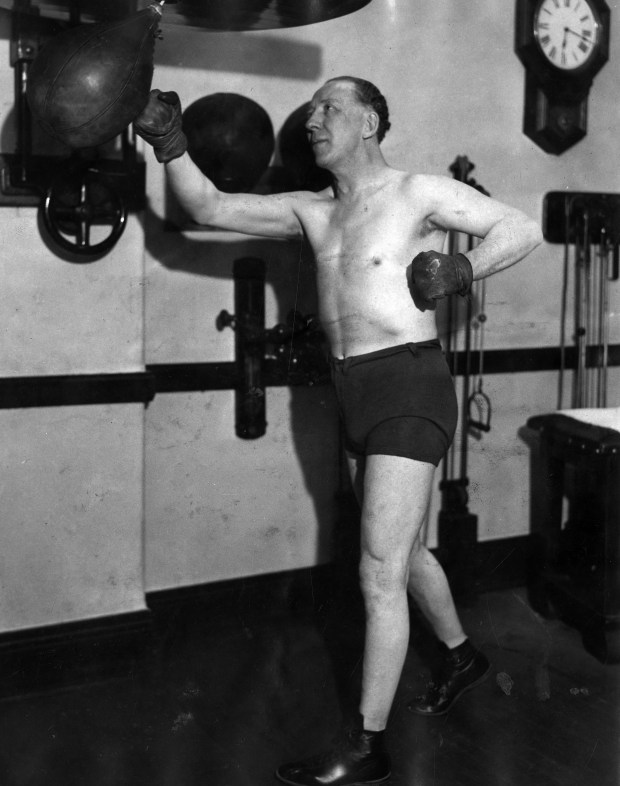
For three minutes Ald. U.S. Schwartz, 4th, and Ald. John H. Lyle, 17th, engaged in a fistfight as a half-dozen of their peers attempted to push them apart.
“Ald. Max Adamowski (38th Ward), well known as an amateur wrestler in former days, gathered Lyle into his arms with a headlock,” the Tribune reported. “Lyle tripped Adamowski and both sprawled over a chair which collapsed on a bench.”
The group had labored for several weeks in preparing an appropriations bill. The Tribune believed the melee helped relieve some of the tension.
No hard feelings were evident — Schwartz and Lyle locked arms and went to dinner together that night.
March 25, 1924: ‘I will never leave Notre Dame’
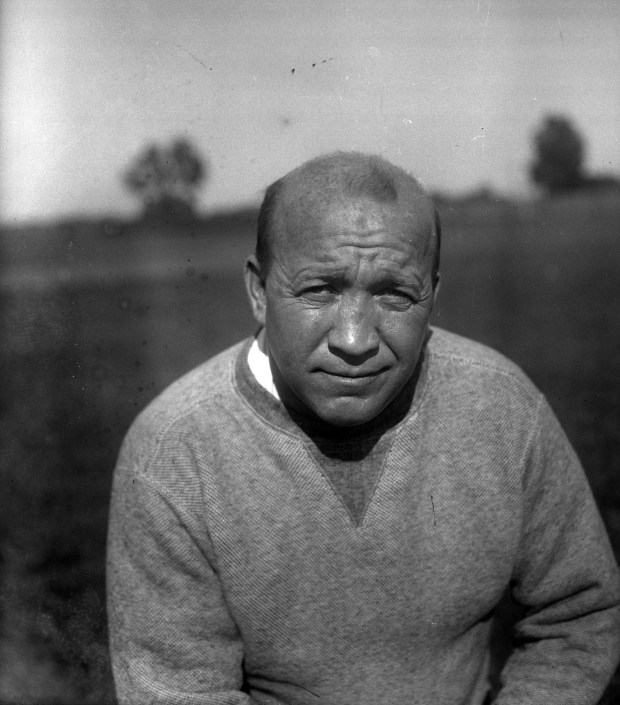
After interest from the University of Iowa threatened to take him out of South Bend, Chicago-raised Knute Rockne signed a contract extension that would keep him at the University of Notre Dame for the next 10 years.
“I will never leave Notre Dame as long as they wish to retain me,” Rockne told reporters.
He died on March 31, 1931, in a plane crash near Emporia, Kansas.
Want more vintage Chicago?
- Become a Tribune subscriber: It’s just $12 for a 1-year digital subscription
- Follow us on Instagram: @vintagetribune
- And, catch me Monday mornings on WLS-AM’s “The Steve Cochran Show” for a look at “This week in Chicago history”
Thanks for reading!
Join our Chicagoland history Facebook group and follow us on Instagram for more from Chicago’s past.
Have an idea for Vintage Chicago Tribune? Share it with Ron Grossman and Marianne Mather at rgrossman@chicagotribune.com and mmather@chicagotribune.com.


